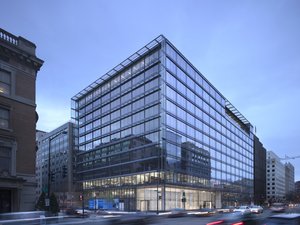
Unbeknownst to daily commuters, the Express Lanes on the greater D.C. area's interstate highways are a hotbed of innovation.
Transurban, which owns I-95 and I-495 Express Lanes in the region, uses the 60 miles of pavement as a testing ground for emerging technologies, especially connected and automated vehicles (CAVs).
The highways offer a controlled, high-speed environment with free-flowing traffic, so Transurban partnered with the Virginia Department of Transportation and the Federal Highway Administration to run connected vehicle trials on its I-95 and I-495 Express Lanes.
It also partners with incubators and startups on programs like the Smart Highways Challenge and the Motorcycle Technology Evaluation Challenge, looking to improve road safety, maintenance efficiency and driver experiences.
DC Inno talked with Robert Deans, head of technology for Transurban North America, about the company's autonomous vehicle testing in Virginia, internet-connected roadway technology and upcoming innovations in the transportation industry.
This interview has been edited for length and clarity.
What kinds of connected or automated technologies are being tested at Transurban?
Robert Deans: One example is last year with 1776, during the Smart Highways Challenge, where we picked two [startups] for product development. One was in the IoT space, a smart solar-powered road stud.
Another is RevMax – we're looking at forecasting tools to plan out maintenance schedules and maximize on-road resources to improve traffic forecasting. We always joke that we have too much data, in some of the most tech-dense roads in America, and AI is one of those things that can crunch through a lot of data and train up algorithms.
Internally, for operations we have thousands of devices on our road that consistently sit out in weather. To go out to fix a device you potentially have to close a lane, so one thing is predictive maintenance. We address something before it actually breaks, and it also helps forecast out how much time it takes to operate on the road.
Where do self-driving cars come into the picture?
RD: We've got a proof of concept that's a geofence for workers on the road, to make sure they are in the right places and then communicate that to autonomous vehicles, notifying cars within sensor range when there’s someone on the road. It allows free-flowing traffic but also safety for workers.
We're also testing self-driving cars in Australia, and we did testing [in the D.C. area] last summer with federal highways and VDOT, during which we learned lot of important lessons.
It’s really about how important it is to have infrastructure in a certain state for those autonomous vehicles. It could be as simple as consistent lane markings, but it's also recognizing what a driver of car wouldn’t think twice about but an autonomous vehicle does, like physical time versus digital time. Depending on the tech used in the car, it needs to react to barriers and obstructions.
How did the D.C. region become a hotbed for this kind of testing?
RD: The D.C. area, as we all know, has quite a bit of congestion. I’ve been here since 2007, and it's definitely vibrant economically and growing. As with lots of megacities, there's lots of opportunity to improve infrastructure and partner with the state to relieve congestion in a way where you can opt in to choose express lanes, but also have improved general purpose lanes.
Right now we're testing devices with VDOT – the proof of concept for geofencing workers and safe areas was run here. We're working with another company on machine learning to better understand pricing on the road.
What are some upcoming advances in transportation tech that you're excited about?
RD: We work with smaller innovative companies in our general business, so in Australia we're looking at how we move more of our internal platforms to be cloud-based, as well as working with Blue Dot on how to let people do tolling and pay for trips with an application – so they see trips on their phone, it's GPS tolling, and they look after the trip's completed as opposed to getting a bill later. We're also working on ways to pick up autonomous rental cars, using express lanes.
There will be continued acceleration as CAVs become more sophisticated and improve, but the question is, does the regulatory environment keep up with that and help that progress? But there are all kinds of interesting things going on in this space, from trials of solar roads – trying to get to carbon-neutral footprints by generating power to light the road – to electrification. As electric vehicles become more prevalent, how do you support that? There are also trials where the car is charging while driving down the road. There's more going on than at any time before, at least since I’ve been in this industry.




